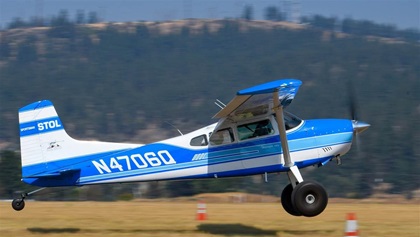Don’t try this at home
Extreme STOL competition-style landings

Veteran pilots will have to unlearn years of ingrained habits.
But if your goal is winning a short-takeoff-and-landing (STOL) contest, you’ll have to master some unconventional and borderline abusive techniques that competitors build their specialized airplanes to tolerate. Steve Henry, a Nevada-based STOL competitor known for viral YouTube videos such as “Deadstick Takeoff, Flight and Landing,” helped pioneer some of these extreme techniques.
It starts with an unstable approach.
Configure your airplane for landing, then get desperately slow. Most pilot’s operating handbooks recommend an approach speed of 1.3 times the power-off stall speed, but STOL competitors tend to fly much slower than that.
 They’re way behind the power curve and deep into what the FAA calls the region of “reverse command,” in which a pilot seeking to fly slower must add engine power to do so. Think of Sean D. Tucker hanging his airplane on its propeller during a “Harrier pass” and you’ve got the concept.
They’re way behind the power curve and deep into what the FAA calls the region of “reverse command,” in which a pilot seeking to fly slower must add engine power to do so. Think of Sean D. Tucker hanging his airplane on its propeller during a “Harrier pass” and you’ve got the concept.
“I get the airplane configured on final approach with full flaps—but it’s not a stabilized approach,” Henry said. “I’m holding a high angle of attack very close to an aerodynamic stall, and I’m constantly working the throttle to adjust the rate of descent to hit my aiming point on the ground.”
Descending close to the ground, there’s no roundout or flare.
Fly a steep approach that directs the airplane’s energy downward. Use the airplane’s pitch attitude to control airspeed and engine power for rate of descent. Then descend at the maximum rate your airplane’s landing gear and supporting structure will tolerate. And just like a Navy pilot hitting an aircraft carrier deck, don’t flare before touchdown.
STOL aircraft are typically equipped with vortex generators, leading-edge slats, and other high-lift devices that allow them to fly at unusually high angles of attack. Henry keeps his aircraft in a nose-high attitude close to its aerodynamic stall with up-elevator and significant engine power as it descends.
 Engine power increases the amount of airflow over the tail, and he raises the nose so that the airplane’s tailwheel impacts the ground first. From that moment forward, the airplane’s angle of attack decreases, and the wings generate less lift. When the main wheels slam down, the airplane doesn’t bounce back up in the air. Shock absorbers and the spongy tundra tires cushion the impact and protect the aircraft from damage.
Engine power increases the amount of airflow over the tail, and he raises the nose so that the airplane’s tailwheel impacts the ground first. From that moment forward, the airplane’s angle of attack decreases, and the wings generate less lift. When the main wheels slam down, the airplane doesn’t bounce back up in the air. Shock absorbers and the spongy tundra tires cushion the impact and protect the aircraft from damage.
Once his airplane is on the ground, Henry holds full aft stick and raises the flaps quickly as he pulls the throttle to idle. Raising the flaps reduces lift and transfers as much weight as possible to the wheels for maximum braking effectiveness.
The aircraft tail usually rises during rollout, and if he senses there’s a danger of nosing over or striking the propeller on the ground, he lightens brake pressure momentarily to allow the main wheels to turn so that the tail stops rising. But he prefers leaving the brakes locked if he can get away with it.
“In wet grass, the tires will slide, and I’ll keep the brakes locked,” Henry said. Henry’s airplane has its main wheels placed unusually far forward, and that allows him to brake aggressively without nosing over.
Henry practices extreme short-field landings in the backcountry so often that he has to remind himself when he flies cross-country never to lock the brakes when he lands on a hard-surface runway. Soft tundra tires don’t last long when a pilot brakes aggressively on pavement, and the danger of a nose-over/propeller strike increases, too.
Save those tricks for the competition where it matters.



